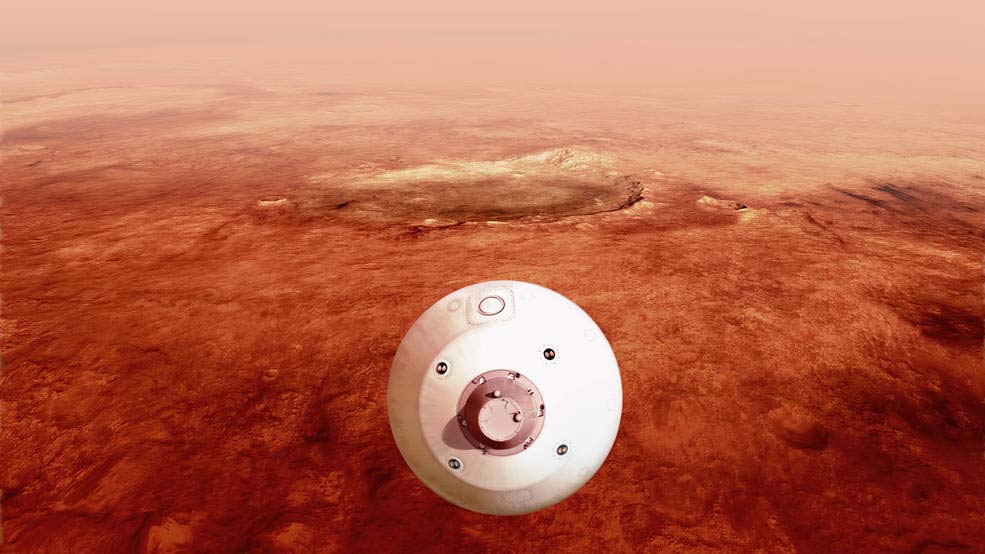With about 3,9-million kilometres left to travel in space, NASA’s Mars 2020 Perseverance mission is days away from attempting to land the agency’s fifth rover on the Red Planet.
Engineers at NASA’s Jet Propulsion Laboratory, where the mission is managed, have confirmed that the spacecraft is healthy and on target to touch down in Jezero Crater at around 3:55 pm EST tomorrow (18 February 2021).
“Perseverance is NASA’s most ambitious Mars rover mission yet, focused scientifically on finding out whether there was ever any life on Mars in the past,” says Thomas Zurbuchen, associate administrator for the Science Mission Directorate at NASA Headquarters in Washington.
“To answer this question, the landing team will have its hands full getting us to Jezero Crater – the most challenging Martian terrain ever targeted for a landing.”
Jezero is a basin where scientists believe an ancient river flowed into a lake and deposited sediments in a fan shape known as a delta. Scientists think the environment here was likely to have preserved signs of any life that gained a foothold billions of years ago – but Jezero also has steep cliffs, sand dunes, and boulder fields.
Landing on Mars is difficult – only about 50% of all previous Mars landing attempts have succeeded – and these geological features make it even more so.
The Perseverance team is building on lessons from previous touchdowns and employing new technologies that enable the spacecraft to target its landing site more accurately and avoid hazards autonomously.
“The Perseverance team is putting the final touches on the complex choreography required to land in Jezero Crater,” says Jennifer Trosper, deputy project manager for the mission at JPL. “No Mars landing is guaranteed, but we have been preparing a decade to put this rover’s wheels down on the surface of Mars and get to work.”
The touchdown will be in separate stages:
* Cruise stage separation: The part of the spacecraft that has been flying Perseverance – with NASA’s Ingenuity Mars Helicopter attached to its belly – through space for the last six-and-a-half months will separate from the entry capsule.
* Atmospheric entry: The spacecraft is expected to hit the top of the Martian atmosphere traveling at about 19 500 kph.
* Peak heating: Friction from the atmosphere will heat up the bottom of the spacecraft to temperatures as high as about 1 300 degrees Celsius).
* Parachute deployment: The spacecraft will deploy its parachute at supersonic speed.
* Heat shield separation: The protective bottom of the entry capsule will detach about 20 seconds after the parachute deployment. This allows the rover to use a radar to determine how far it is from the ground and employ its Terrain-Relative Navigation technology to find a safe landing site.
* Back shell separation: The back half of the entry capsule that is fastened to the parachute will separate from the rover and its “jetpack” (known as the descent stage). The jetpack will use retrorockets to slow down and fly to the landing site.
* Touchdown: The spacecraft’s descent stage, using the sky crane maneouvre, will lower the rover down to the surface on nylon tethers. The rover is expected to touch down on the surface of Mars at human walking speed about 2,7 kph).
Once on the surface, one of Perseverance’s first activities will be to take pictures of its new home and transmit them back to Earth. Over the following days, engineers will also check on the health of the rover and deploy the remote sensing mast (otherwise known as its “head”) so it can take more pictures.
The Perseverance team will then take more than a month to thoroughly inspect the rover and load new flight software to prepare for its search for ancient life on Mars. During the same period, the Ingenuity Mars Helicopter team will be making sure the robot is prepared for the first attempt at controlled, powered aerodynamic flight on another planet.
“The Ingenuity team will be on the edge of our seats with the Perseverance team on landing day,” says MiMi Aung, the Ingenuity project manager at JPL. “We can’t wait until the rover and the helicopter are both safely on the surface of Mars and ready for action.”
More about the Perseverance mission
A key objective of Perseverance’s mission on Mars is astrobiology, including the search for signs of ancient microbial life. The rover will characterise the planet’s geology and past climate, pave the way for human exploration of the Red Planet, and will be the first mission to collect and cache Martian rock and sediment for later return to Earth.
Subsequent NASA missions, in cooperation with ESA (European Space Agency), would send spacecraft to Mars to collect these sealed samples from the surface and return them to Earth for in-depth analysis.
The Mars 2020 mission is part of a larger NASA initiative that includes missions to the Moon as a way to prepare for human exploration of the Red Planet. NASA will establish a sustained human presence on and around the Moon through NASA’s Artemis lunar exploration plans.
Featured picture: The aeroshell containing NASA’s Perseverance rover guides itself towards the Martian surface as it descends through the atmosphere in this illustration. Hundreds of critical events must execute perfectly and exactly on time for the rover to land on Mars safely on 18 February 2021.
Credits: NASA/JPL-Caltech

